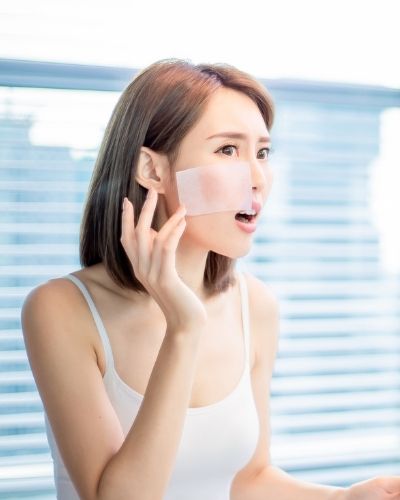The first step in selecting the right skin solution and routine is by determining your skin type.
If you have no idea what your skin type is, fret not as in this article I am going to show you how to go about determining your skin type.
Here’s what is covered in this article:
- How to determine your skin type?
- What are the four types of skin?
- How to distinguish a skin type from a skin condition?

How To Determine Your Skin Type?
Determining your skin type can be a challenging task that will frustrate every nerve in your body, unless you do it the right way, of course.
Every person’s skin is unique, but for sanity’s sake, we can place the most common skin types in several categories.
However, your skin type may be accompanied by one, or more skin conditions that I will also list down below so you can do a great job in figuring out what exactly is it that your skin needs.
There are two basic methods to determine your skin type, these are:
- The Bare Face Method.
- The Blotting Sheet Method
1. The Bare Face Method

This is something that you should do before you go to bed for the best results, and I will show you exactly how to do it.
Cleanse your face thoroughly with your usual cleanser and gently pat dry.
Leave your skin bare without applying any additional toners, serums, moisturizers, treatments, and what have you.
It might sound scary at the beginning, but it is a good practice to be able to figure out what you are dealing with here. Just go to sleep, I am pretty sure you need it. The results will be ready for you as soon as you wake up.
The next step is to examine your face in the morning (like you are not already doing that whenever a new pimple pops up) and pay close attention if there is any shine, or the lack of it for that matter on the forehead, nose, cheeks, and chin.
A little morning facial exercise is a great way to evaluate whether your skin feels tight, especially if you smile or make any other facial expression.
If your skin feels like you just washed it a few minutes ago and there is very little oil to be noticed, your skin is likely to be leaning towards the dry type.
On the other hand, if there is noticeable shine on your forehead, nose, and chin – your skin falls into a combo type, which is the most common skin type.
Moreover, if you notice obvious signs of oil spread across your cheeks too in addition to your forehead, nose, and chin, this means that you most likely have oily skin.
And lastly, if your skin feels pretty normal without any uncomfortable tightness or undesirable grease, congratulations!
You are the proud owner of normal skin type and you have absolutely nothing to worry about, besides maintaining a very minimal skincare regimen to complement your natural radiance.
If you are still not sure what’s happening and you want to try yet another way to figure out where you stand, there’s one more method of determining your skin type.
2. The Blotting Sheet Method

This method is much faster and a good enough differentiator between oily and dry skin types.
All you need is some blotting paper, and if you don’t feel like hassling yourself to go to the nearest pharmacy and buy a packet, you can easily use a tissue that you will separate so you can get the thinnest layer of paper.
Wash your face and keep it product-free for about two or three hours. Scroll the f*ck out of your social media during this time.
Then gently pat the blotting paper or tissue in different areas of your face. Press a small sheet over your forehead, down your nose, cheeks, and chin.
Hold the sheet up to the light to determine how much oil is visible.
If the sheet picked up little to no oil, you are most likely to have normal skin that’s leaning towards the dry side.
If the sheet reveals oil from the forehead, nose, and chin areas, your skin is most likely to be combo to oily.
And finally, if the sheet is saturated with oil, it is extremely likely that you have oily skin and that face needs cleansing, ASAP.
The Four Skin Types Explained
Some time ago, when I was in your situation, I was browsing through every single website out there to try and find answers on how to take good care of my skin like my life depended on it.
I must say that the explanations I used to run into were rather complicated and often left me even more confused than I was before.
The truth is that figuring out the skin can sometimes be confusing, but it is by no means complicated.
Let’s take a look at the four most common skin types and what do they mean.
1. Normal Skin
This is the most desired and at the same time most rare skin type as once hormones begin changing your body during puberty, your skin will become more oily and with age, it becomes drier.
This skin type is perfectly balanced with cell renewal working in harmony with the exfoliation of dead skin cells.
It has an excellent moisture-holding capacity with sebum and sweat being secreted at a perfect rate to maintain the acid mantle and keep it healthy.
The skin looks clear and it has an even tone without any visible discoloration. It feels neither tight or greasy and it is soft and supple to the touch.
It also has a good level of elasticity and is perfectly toned due to good collagen production.
To help maintain this perfectly balanced and healthy-looking skin, you should opt for minimum-maintenance skincare without suffocating it with heavy products that you essentially don’t need.
Prep your skin with a gentle cleanser, hydrate with a light, hydrating moisturizer and always protect it with a broad-spectrum sunscreen during the day.
2. Dry Skin
Dry skin is generally lacking moisture and natural oil that is produced by your sebaceous glands in order to keep your skin lubricated and moisturized.
This is caused by underactive sebaceous glands that don’t produce enough natural oil to keep the skin lubricated and moisturized.
Dry skin is most likely hereditary but it can also be that the water-holding capacity of your skin may have been disrupted due to harsh environmental conditions.
Dry skin is often pale in color and has a thin epidermis. It tends to feel tight and uncomfortable after cleansing and it can appear dull and flaky.
It is also characterized by premature fine lines and wrinkles that happen due to the collagen breakdown.
Daily exfoliation with gentle, non-abrasive ingredients may promote cellular turnover without removing the little natural oil you have on the surface of your skin.
Look for formulas that hydrate, nourish, and moisturize but don’t neglect to protect your dry skin with a broad-spectrum sunscreen daily.
Opt for formulations that are free from alcohol, fragrances, artificial dyes, and harsh chemicals as these tend to be harsh even towards oily skins, not to mention what they may do to your dry, vulnerable skin.
3. Combination Skin
From a certain age, you will probably start to have characteristics from more than one of the four skin types.
If you are someone that has combination skin, you may often be experiencing dryness on the cheeks, while your T-zone can become quite oily throughout the day because the sebaceous glands tend to be more active in that area.
For this reason, it is important to find a moisturizer that is not too heavy but substantial enough to maintain moisture in areas where your skin needs it most.
Gentle, daily exfoliation is also important to keep the T-zone clean and free of congestion but also the cheek areas balanced.
Moisturizers with a gel-like texture are absorbed more quickly and are less likely to cause breakouts in oily areas.
4. Oily Skin
Oily skin is characteristic due to the overproduction of oil, and it is one of the skin types you don’t really need any sort of testing to realize you have it.
It is most common in adolescents and young adults because of the increase in the rate of sebum production influenced by the hormone androgen that becomes active during puberty.
Oily skin characteristics may include a sallow complexion, a thick epidermis with coarse areas on the face, and the most common complaints that are open pores prone to clogging and thus breakouts.
Daily gentle exfoliation is essential to minimize congestion as well as prevent a build-up of sebum in the pores. Exfoliation will also refine the textured and dull-looking complexion due to promoting cellular turnover and renewal.
3 Skin Conditions You Should Know About
As I mentioned above, every skin is unique, and while you may be thinking that you have more than one skin type, you may actually be mistaken for having a certain, often self-inflicted condition combined with your skin type.
Let’s list some of the most common skin conditions:
1. Dehydrated Skin
Dehydrated skin distinguishes itself from dry skin because dry skin lacks both moisture and oil while dehydrated skin is often accompanied by an excessive amount of oil on the skin’s surface.
But how can this be?
This occurs because your skin is lacking in moisture (water), and as a result of this it tries to compensate by producing more oil to keep itself hydrated by keeping moisture in.
Despite the excess oil, your skin still feels tight or dry everywhere on your face and the appearance is usually paper-thin-like and dull.
2. Congested Skin
Congested skin more broadly refers to skin conditions where there is an impaction within your pores.
The impaction can be a combination of oil, dead skin cells, dirt, debris, and bacteria from the surface of the skin entering the pore and clogging it.
There are several factors that cause congestion and these can be:
- insufficient or a poor cleansing routine
- incorrect skincare regimen
- using comedogenic ingredients on the skin (coconut oil, I have my glare set on you.)
- overuse of makeup products
- insufficient exfoliation
But if these don’t describe you at the slightest, looking into your diet and gut health may be the next stop.
NB: Make sure to check out the links I have added to some of my previous articles that go in great depth regarding the listed skin concerns.
3. Sensitive Skin
While writing this article, I struggled whether categorizing sensitive skin into a skin type or a skin condition, I decided on the latter, and here’s why.
Sensitive skin is becoming increasingly common due in part to the environment but also to the sensitivity of many people to external stimulants.
This can mean allergies to certain ingredients, sensitizing the skin with overuse of harsh products, extreme weather conditions such as strong winds or extreme heat, and many other things that can come in contact with your skin and can easily irritate it.
Sensitive skin often appears thin and fragile, has a translucent-like appearance, feels very tight after washing, and reacts to external stimuli by becoming red, blotchy, and inflamed.
It is also very prone to dry, flaky patches and broken capillaries and requires special attention and care with using only the mildest products that contain nourishing and non-irritating ingredients.
While determining your skin type may feel like a daunting task…
I hope by reading my guide you’ve learned a few things to help you figure out what skin type you are dealing with. If you’re still not sure, do not hesitate to get in touch with me on Twitter.

My name is Simone and I am a certified skin specialist. I created this website to teach my readers how to take great care of their skin and I also like to occasionally share my honest opinions on skincare products I’ve tried. You can learn more about me here.
